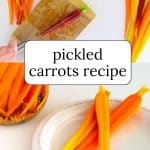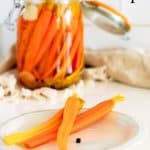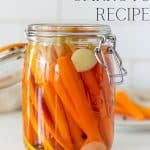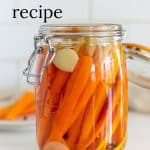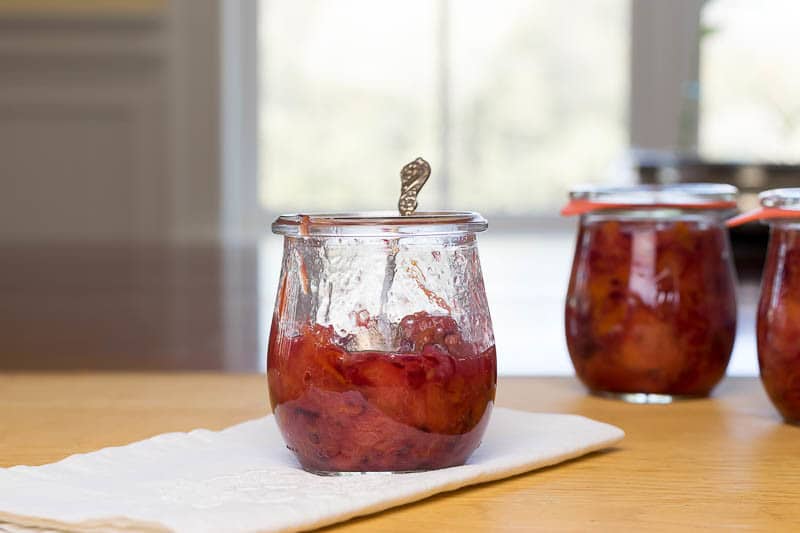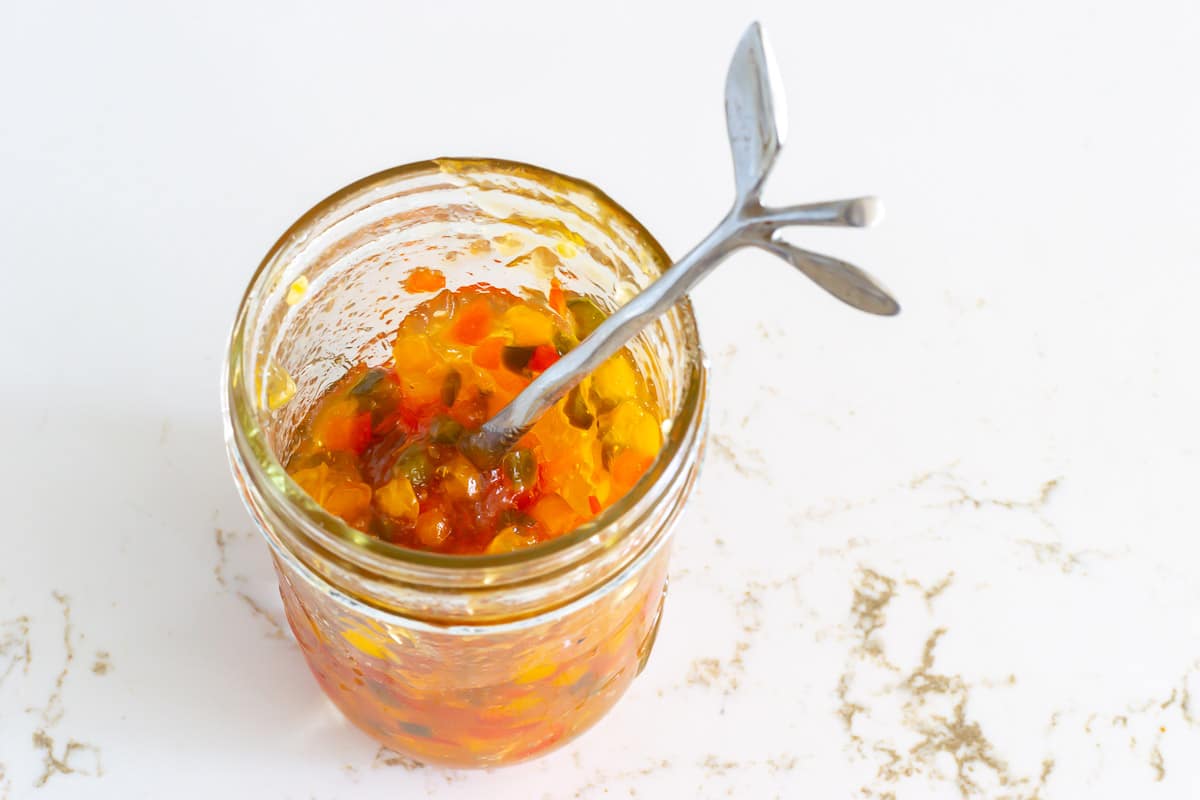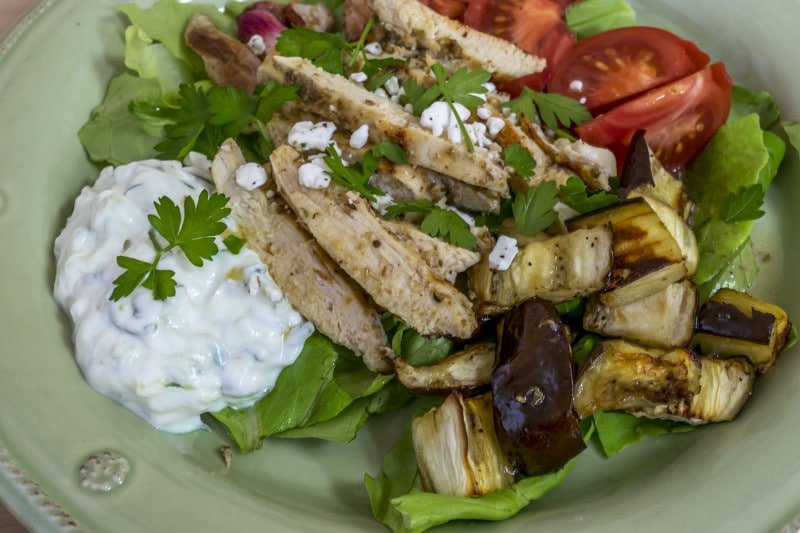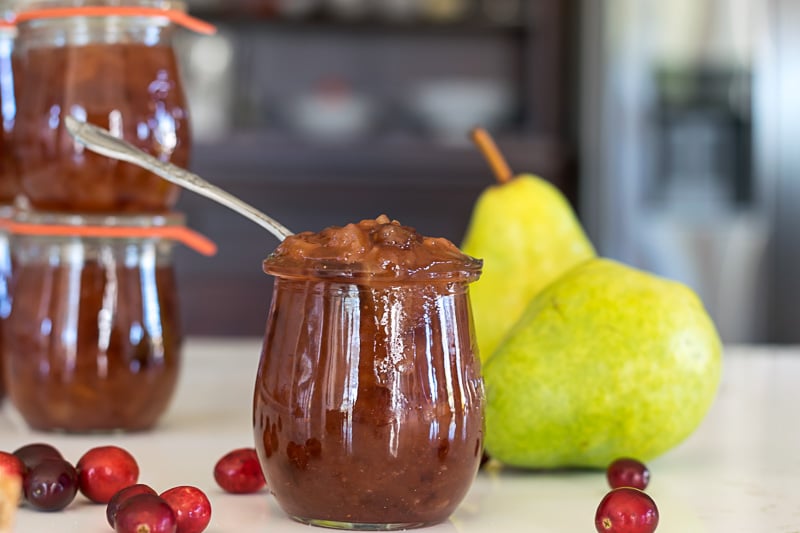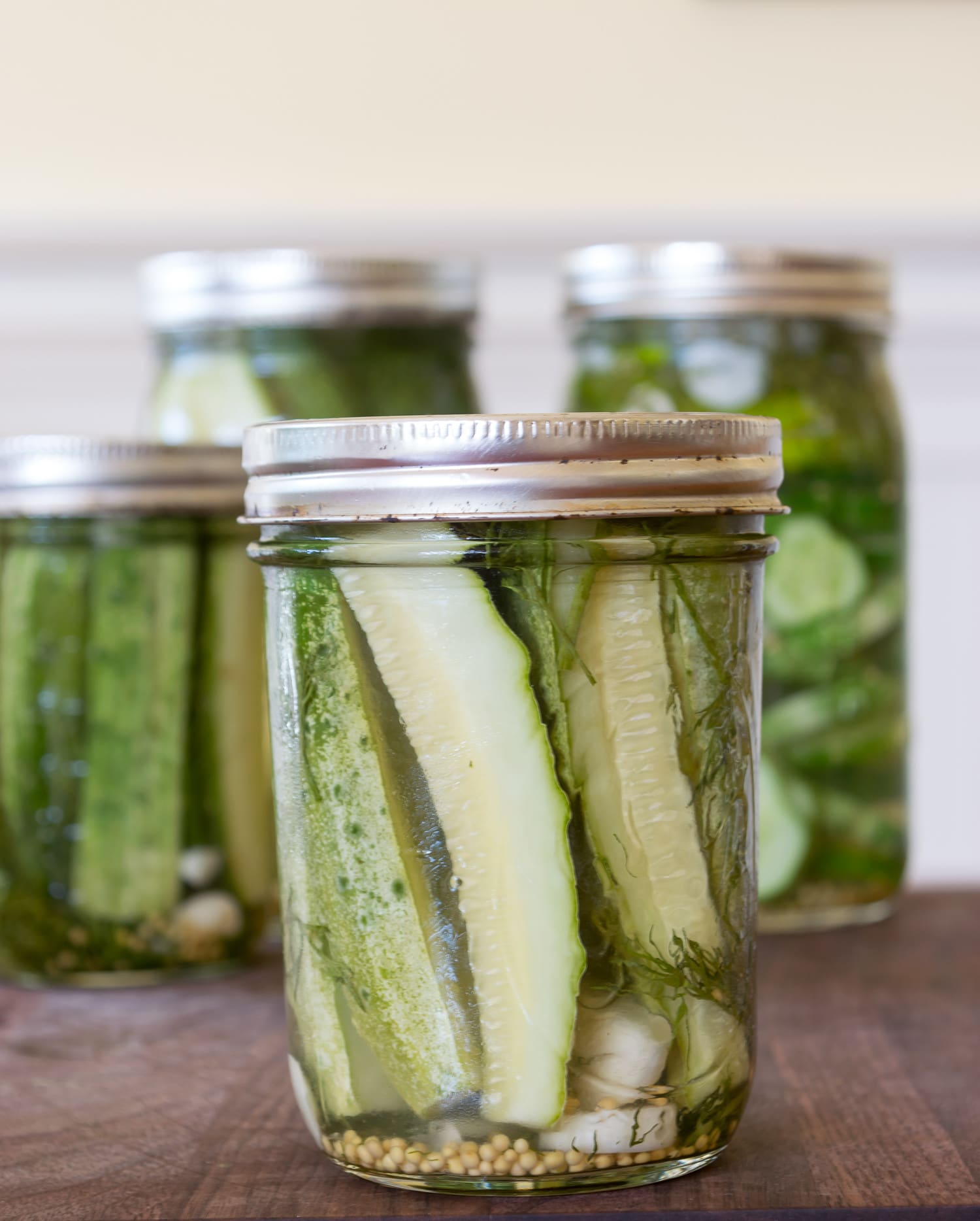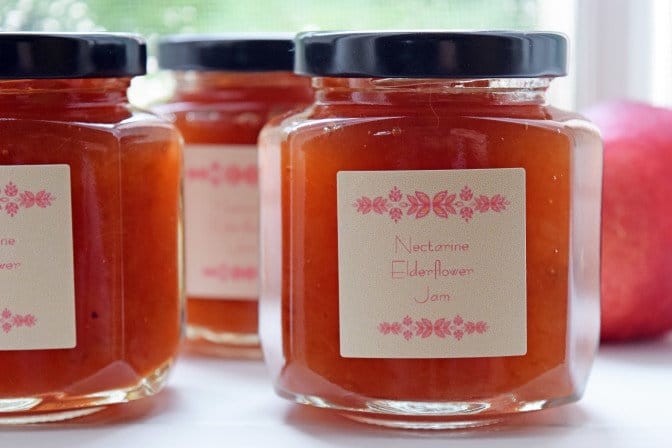Pickled Carrots Recipe: Quick or Canned
Homemade Pickled carrots are a vibrant, tangy treat that can elevate any meal. They are perfect for sandwiches, salads, or a standalone snack. Dice them, chop them, or keep them whole. On top of producing a delicious vegetable treat, this quick pickled carrots recipe is also an ideal way to preserve an excess of carrots, ensuring they’re enjoyed for weeks or even months to come.
This easy recipe offers a basic recipe to pickle carrots. The joy of pickling is that it’s as much art as science, allowing you to experiment with different spices and flavor profiles. This easy pickled carrots recipe with traditional white vinegar, sugar, salt, and water brine. Then we can build layers of flavor by adding garlic, black peppercorns, mustard seeds, cumin, and a bay leaf. But you can leave some of these spices out or add some of your favorites.
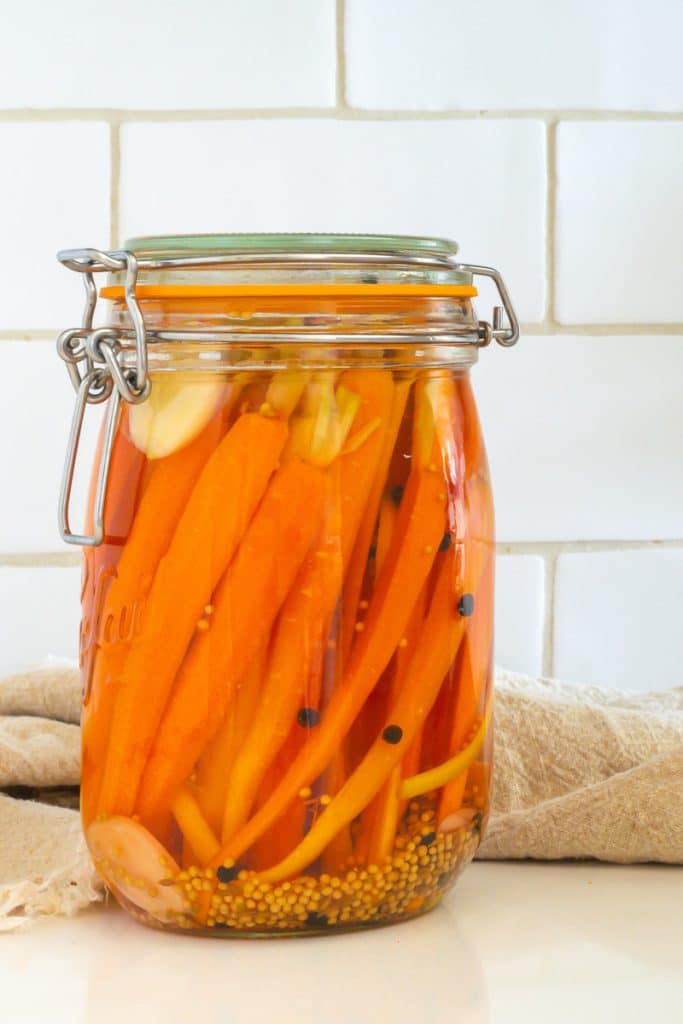
Table of Contents
And there are numerous options to which vinegar to use! Just ensure you stick with vinegar with an acidity of 5% or greater.
Why Do You Need Vinegar with 5% Acidity When Pickling?
It is widely recommended that vinegar should have an acetic acid level of at least 5% for safe at-home pickling. This acidity is sufficient to create an environment that’s too acidic for most harmful microorganisms to survive while still being palatable for human consumption.
This is also the standard acidity level for most commercially available vinegar suitable for consumption. If you’re making pickles or any other preserved food, always ensure that the vinegar is at least 5% acidity.
Ingredient Notes for These Quick Pickled Carrots
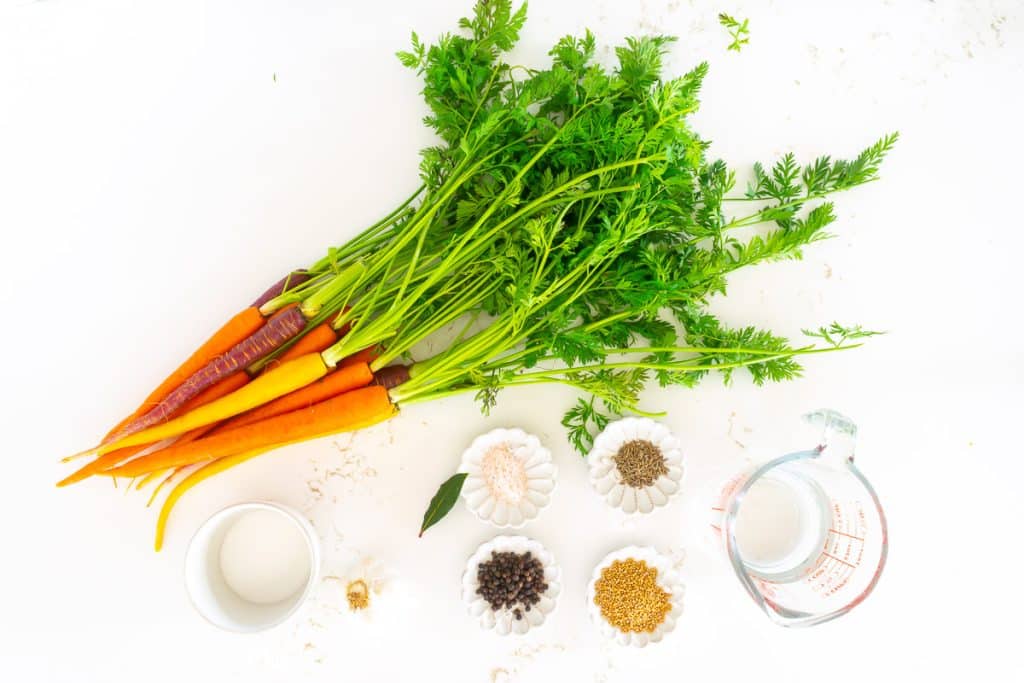
One pound of fresh carrots: Choose firm, fresh carrots with bright orange color. The fresher the carrots, the crunchier your pickles will be. Wash them thoroughly and peel them if you like, but it’s unnecessary if they’re organic or home-grown.
A note on rainbow carrots: I love rainbow carrots for the variety of gorgeous colors. Just know the purple carrot dye will leave the carrot and bleed into the brine. That’s not necessarily a bad thing, just something good to know.
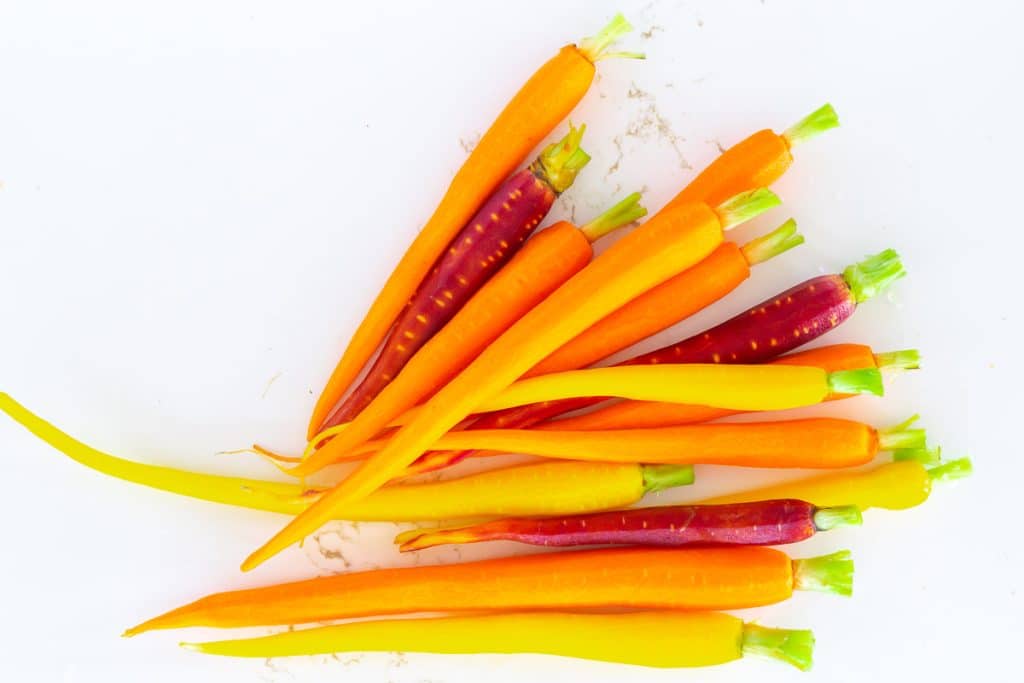
Garlic Cloves: The number of cloves can be adjusted based on personal taste. If you want a strong garlic flavor, use 3-4 cloves; for a milder flavor, use 1-2. Peel and slice the garlic cloves.
Two cups white vinegar: This gives the pickles their acidity. White vinegar is most commonly used for pickling due to its clear color and relatively neutral flavor. However, if you prefer, you can experiment with other vinegar such as apple cider, rice vinegar, or wine vinegar, but again, be mindful that you should stay with 5% acidity vinegar.
Water: This is used to dilute the vinegar, making the brine less acidic.
1/8 – 1/4 cup of sugar: Sugar helps balance out the acidity of the vinegar. Feel free to adjust the amount of sugar to taste. If you prefer sweeter pickles, add more; if you prefer more tangy pickles, use less. The 1/8 cup of sugar is on the low side; feel free to taste the brine before adding it to the carrots to determine if you want more sugar.
Salt: Use non-iodized salt, such as kosher salt, sea salt, or pickling salt, to avoid discoloration of the pickles and cloudiness in the brine. The amount can vary depending on taste; these pickles only use one teaspoon, which is on the low side.
Black Peppercorns give the pickles a slightly spicy, aromatic flavor.
Mustard seeds add a tangy, somewhat spicy flavor to the pickles.
Cumin seeds add an earthy, warm flavor.
Bay Leaf: Bay leaves have a subtly sweet, spicy, and slightly floral flavor with hints of pine and clove. They can be pretty potent, so don’t overuse them.
How To Make These Quick + Easy Carrot Pickles

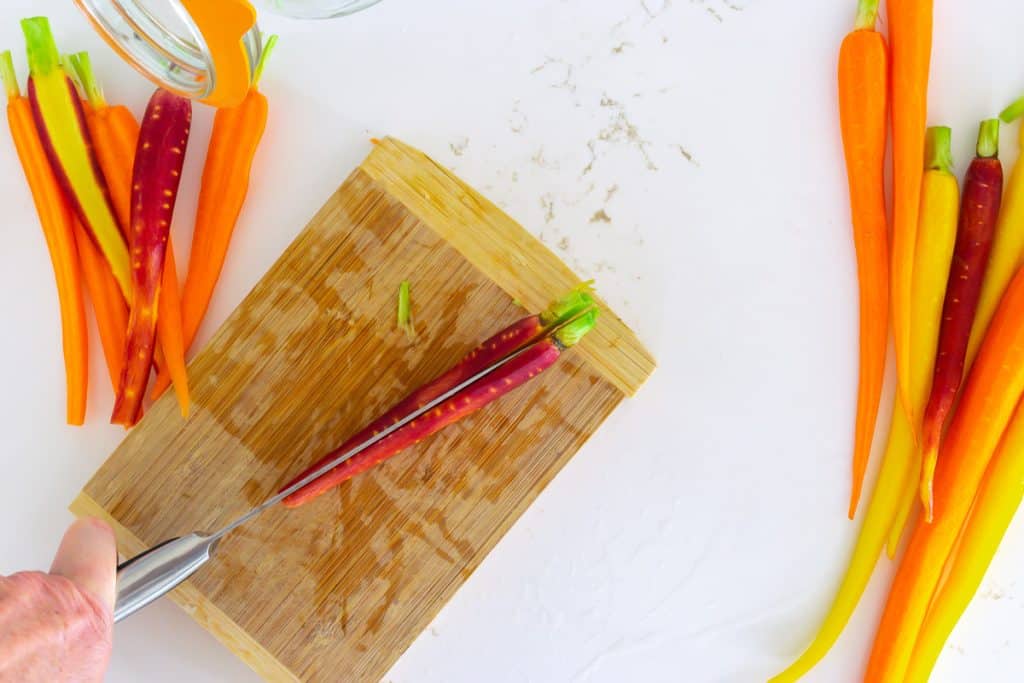
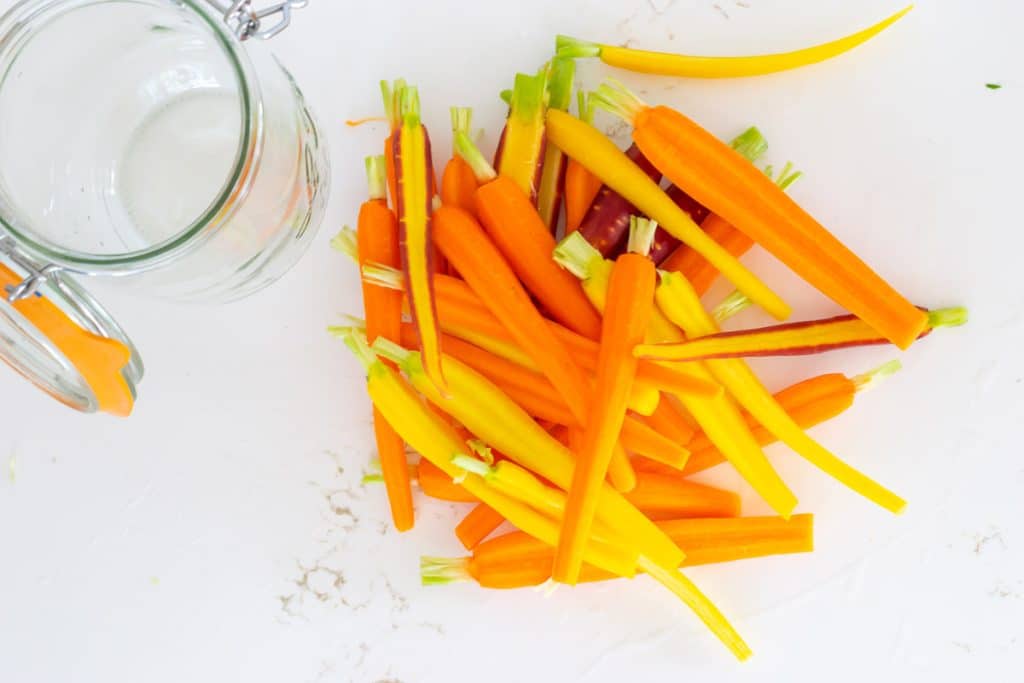
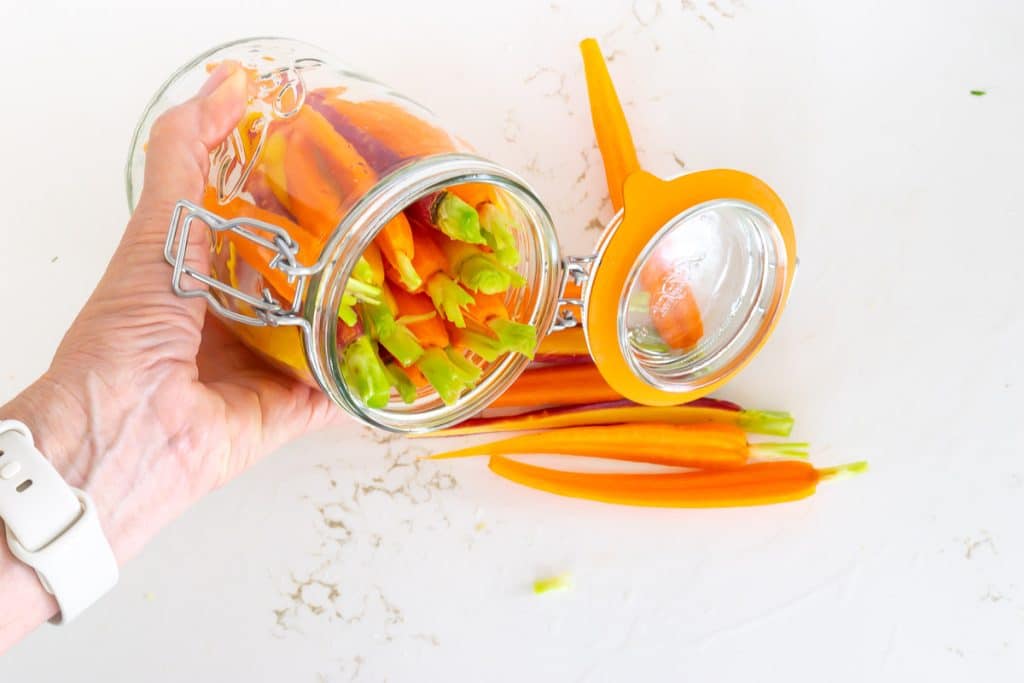
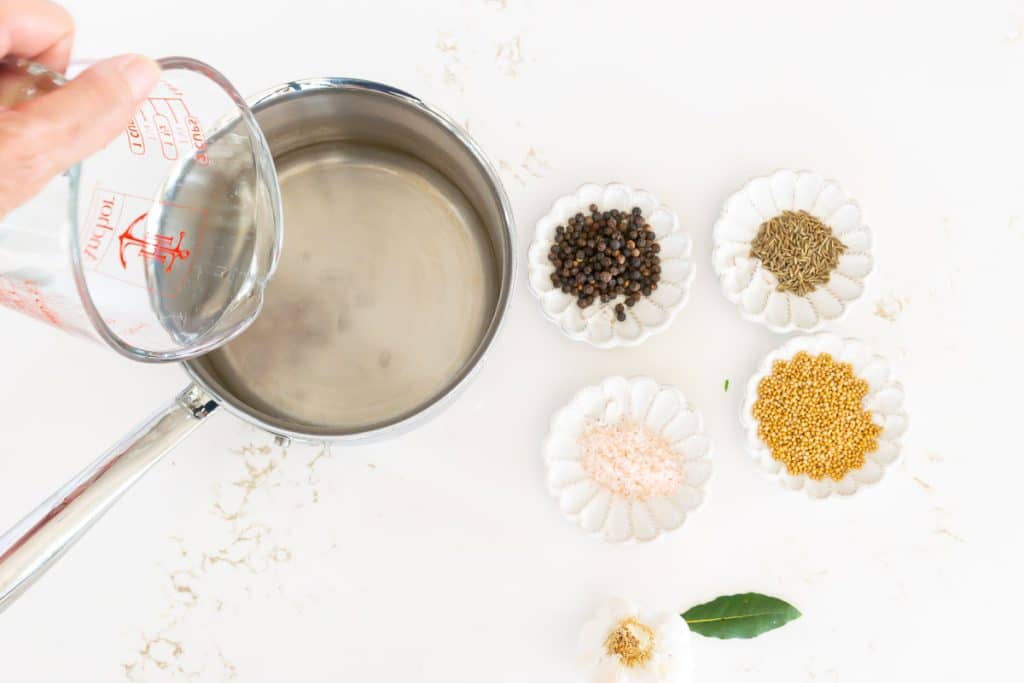
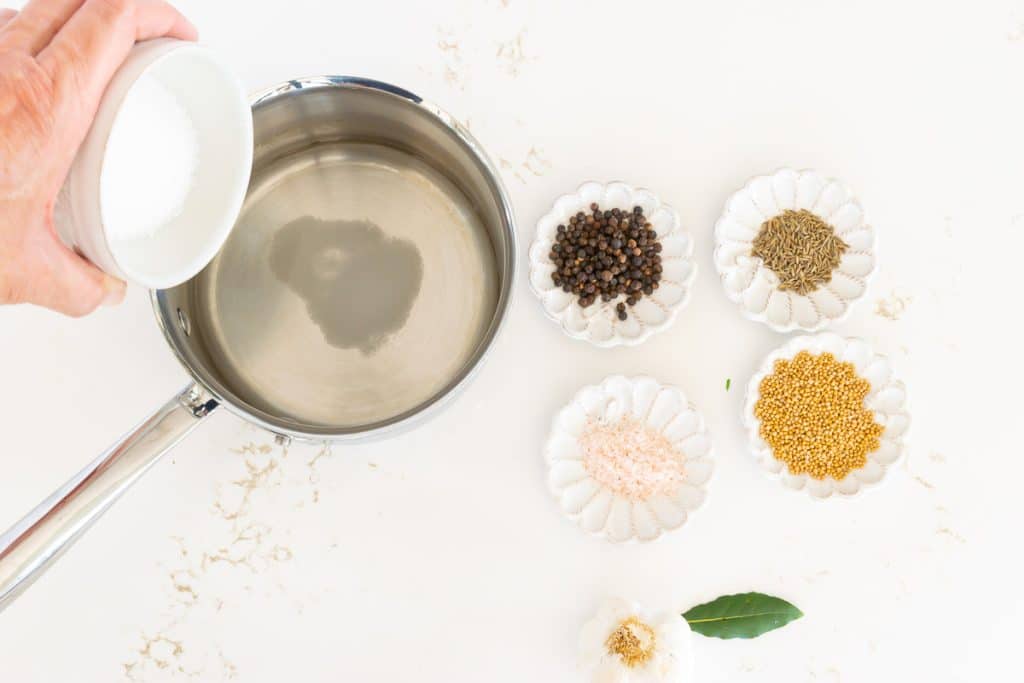
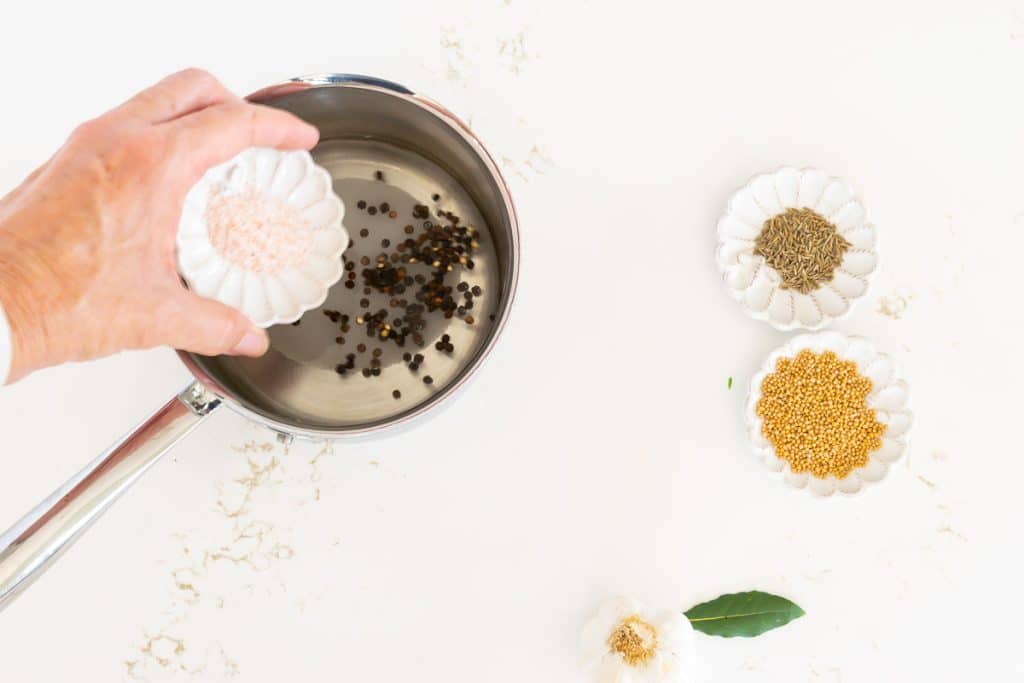
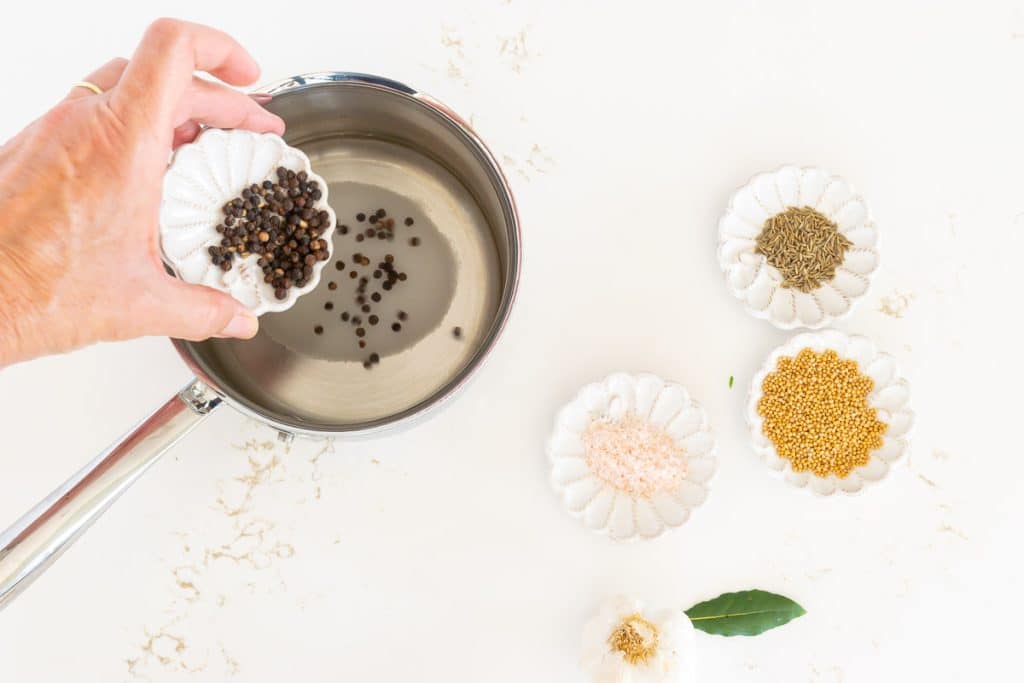
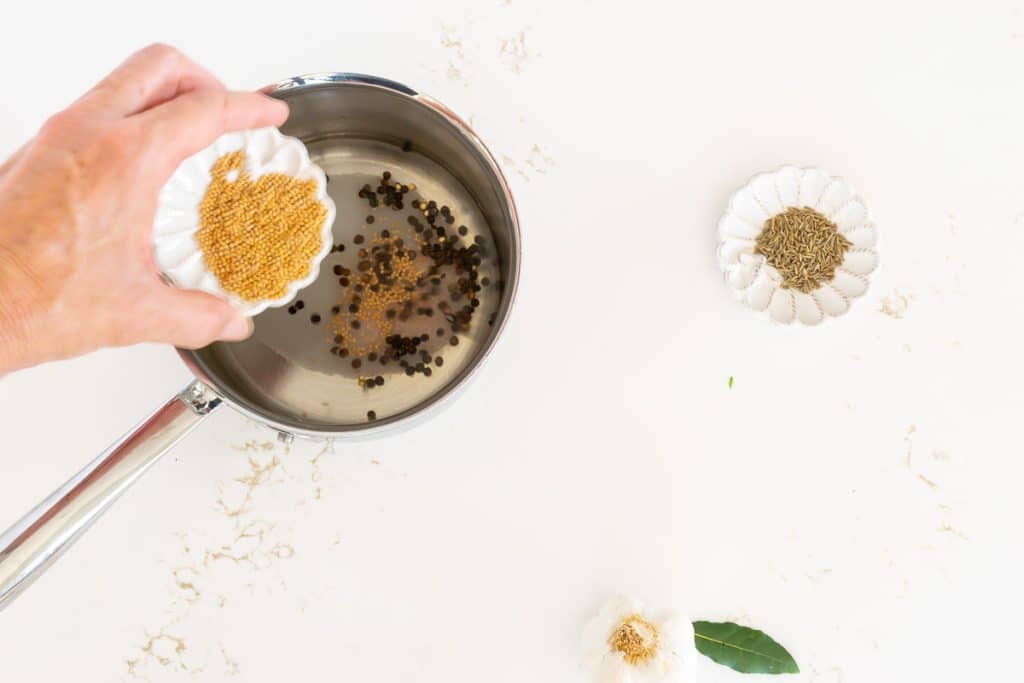
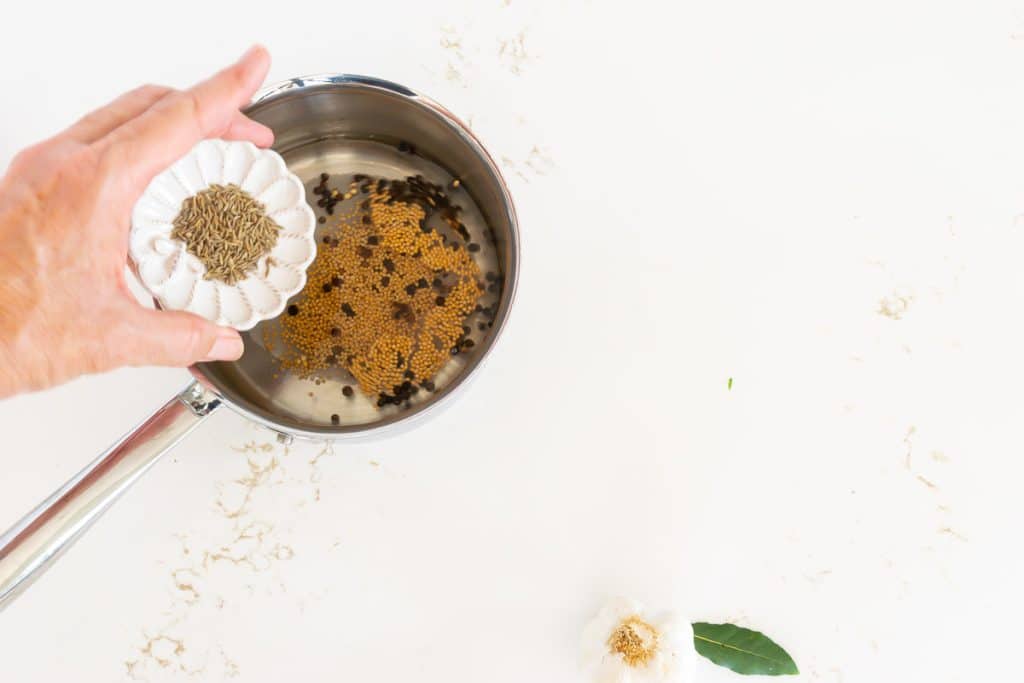
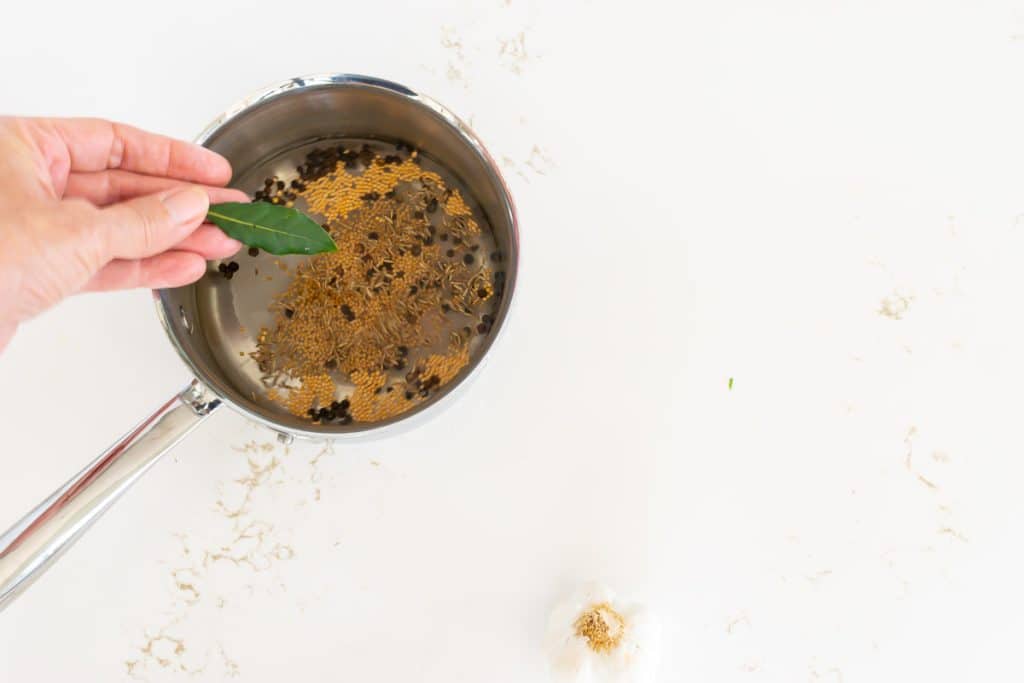
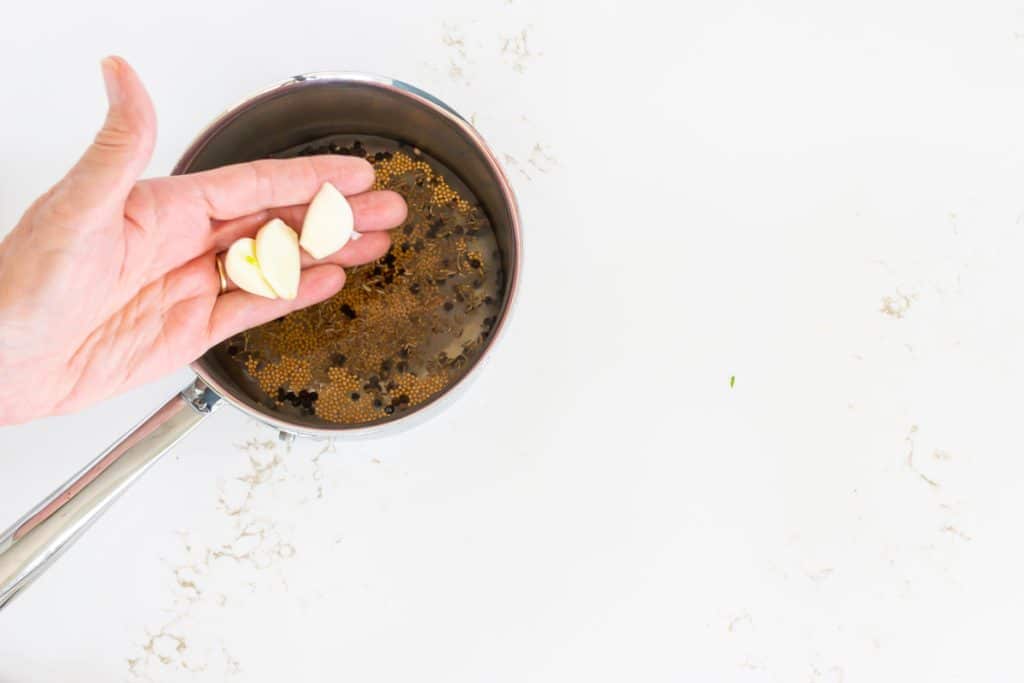
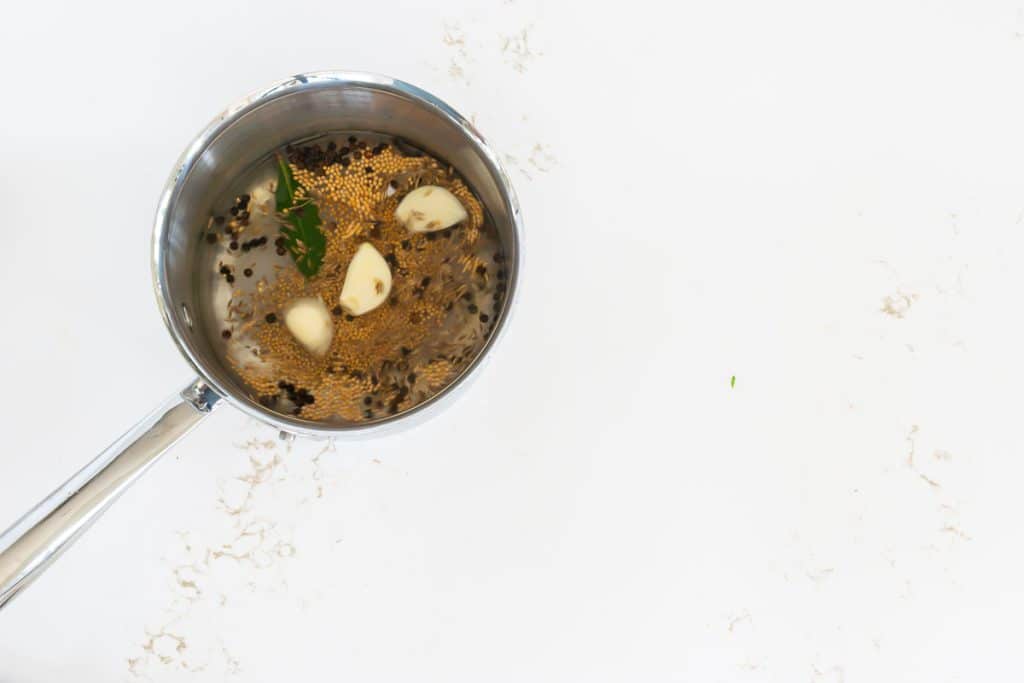
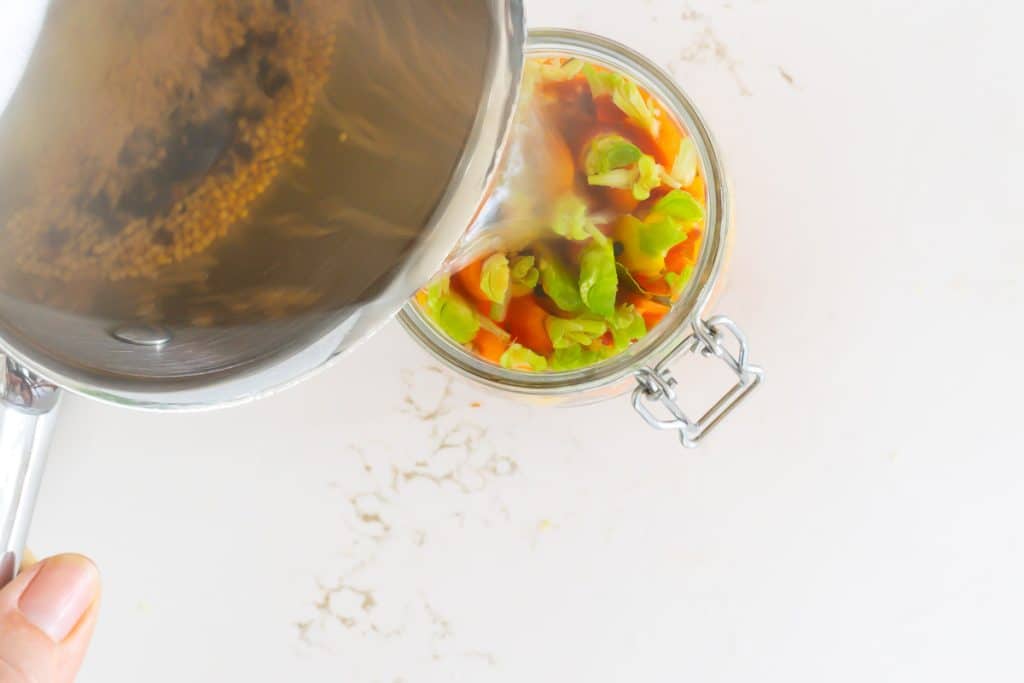
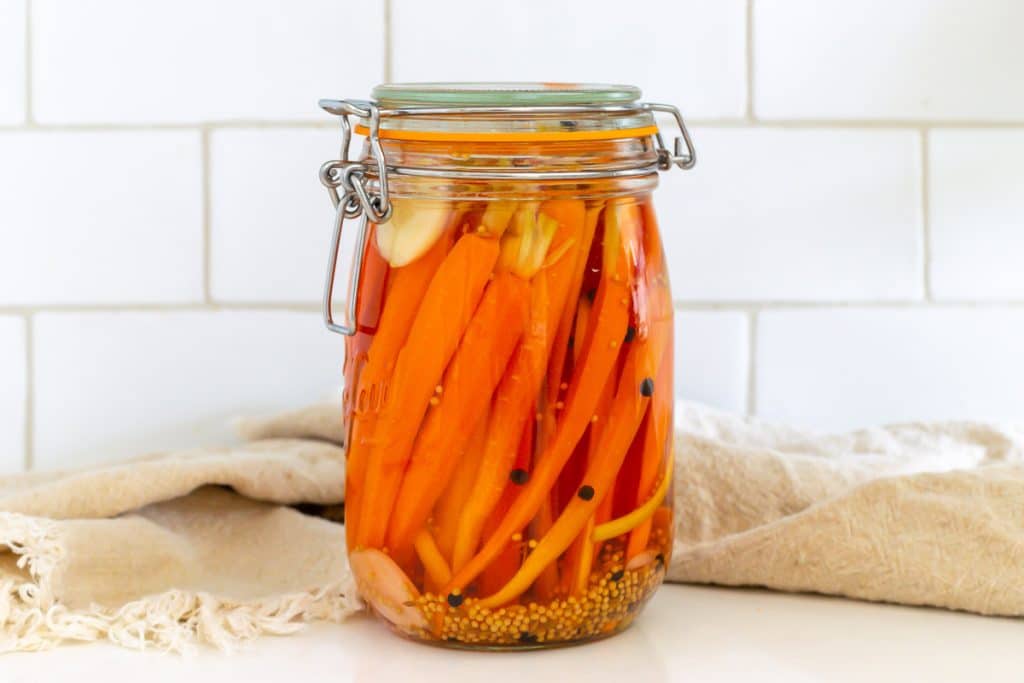
Making Pickled carrots couldn’t be easier!
- Peel (if desired) your carrots and trim them in similar sizes. I cut mine in half lengthwise and then trimmed the tips to fit in the jar.
- Make the brine by adding vinegar, water, sugar, salt, peppercorns, mustard seed, cumin seed, bay leaf, and sliced garlic cloves to the brine. Bring it to a boil.
- Once the brine has boiled, remove the brine from the stove and pour over carrots.
- Seal your jar and let your carrots sit on the counter until they have cooled to room temperature.
- Refrigerate your pickled carrots. They are best after a week, but you can truly eat them whenever you want.
Some of these links may be Amazon affiliate links and I may earn a small commission from the sale of these products to help defray the costs of operating this site, but the price you are charged is not affected. You can see my full disclosure policy here.
If You Want To Water Bath Can These Carrot Pickles
Your two options for making carrot pickles include quick pickling or refrigerator pickles and water bath canned pickles. Canning in a water bath makes your pickles shelf-stable, while quick pickled vegetables should be kept in the refrigerator.
The recipe card includes instructions if you want to water bath can your pickled carrots to make them shelf stable. I highly recommend The All New Ball Book of Canning and Preserving if you are new to canning. It is my bible.
RecipeTips
Select fresh ingredients: This will ensure your pickles are crunchy and flavorful. Avoid using limp or old carrots.
Prepare your jars: Make sure your jars are clean and sterilized to prevent any unwanted bacteria from spoiling your pickles.
Evenly cut your carrots: This will ensure even pickling. You can slice large carrots into coins or sticks or leave them whole if they’re baby carrots.

Balancing the brine: The vinegar, water, salt, and sugar should all be balanced for a good pickle.
Use the right salt: Use non-iodized salt, such as kosher salt, sea salt, or pickling salt. Iodized salt can make the pickling solution cloudy and may alter the color and taste of the pickles.
Let the jar of pickles rest: After filling your jars with the brine and sealing them, let them cool to room temperature and then rest in the refrigerator. These pickles reach their prime in one week but try to at least wait 24-48 hours before eating. This allows the flavors to develop and the carrots to absorb the brine.
Experiment with flavors: Don’t be afraid to change up the spices. Add different whole spices or fresh herbs to change the flavor profile. Just remember that the flavor will intensify the longer the pickles sit. But you can still taste your brine before you pour it over the carrots. If you find it too tart, add more sugar to take the edge off the vinegar.
Packing the jars: Pack the carrots tightly in a glass jar with a lid, but be careful not to crush them. The brine must cover the carrots fully, and there shouldn’t be too much empty space in the jar.
Seal properly: Make sure the jars are properly sealed before storing them. You don’t want air getting in, which could lead to spoilage.
Variations and Substitutions
There are many ways to vary this recipe and substitute ingredients to suit your taste. Here are a few ideas:
Vinegar: Instead of white vinegar, try apple cider vinegar for a sweeter, fruitier taste or red wine vinegar for a deeper, more complex flavor. With either of these two kinds of vinegar, be mindful that your brine will take on the color of the vinegar. Rice vinegar could also work, particularly for an Asian-inspired pickle. Whatever vinegar you choose, check the label that it is 5% acidity.
Sweeteners: If you want to avoid regular sugar, you could substitute honey or maple syrup, though this will alter the taste. Consider a sugar substitute like Stevia for a non-caloric option, but check conversion rates as these can be much sweeter than sugar.
Spices: Feel free to play with different spices based on your preferences. Coriander seeds, allspice berries, pink peppercorns, or red pepper flakes for a kick are all good options.
Vegetables: You could add other vegetables to the mix. Add fresh, crisp pearl onions, sliced bell peppers, or cauliflower florets to your pickled carrots to make pickled vegetables! You could also add some fresh, sliced hot peppers if you like your pickles with a bit of heat.
Herbs: Fresh dill, thyme, or rosemary sprigs can add a different layer of flavor to your pickles. Simply add a sprig or two to each jar before sealing.
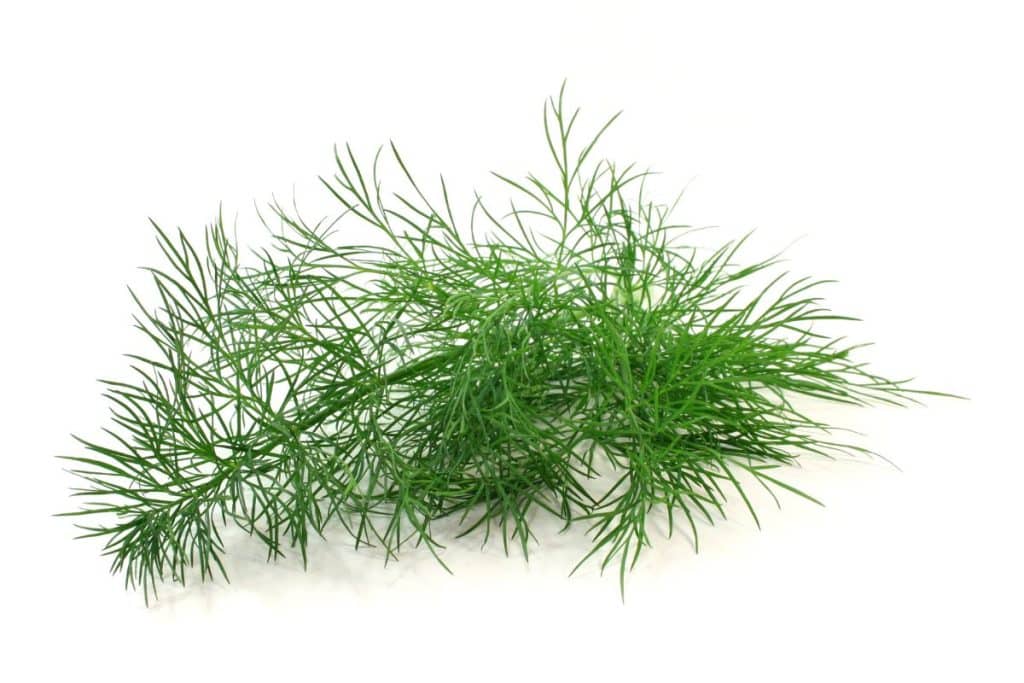
Give your carrot pickles recipe an ethnic twist! Leave out the mustard seed and add a teaspoon of dried oregano for a Mexican or Latin spin on carrot pickles. If you’d like to make Asian or Vietnamese Pickled Carrots, leave the mustard seed and cumin out, add a slice or two of fresh ginger, and swap rice wine vinegar in the brine.
Remember, the balance of vinegar, water, and salt in your brine is the key to successful pickling. If this balance is maintained, experiment with different flavors and ingredients. Enjoy your culinary creativity!
Other Pickle Recipes
Are you in a pickling pickle? Never fear; we’ve got pickle recipes for you!
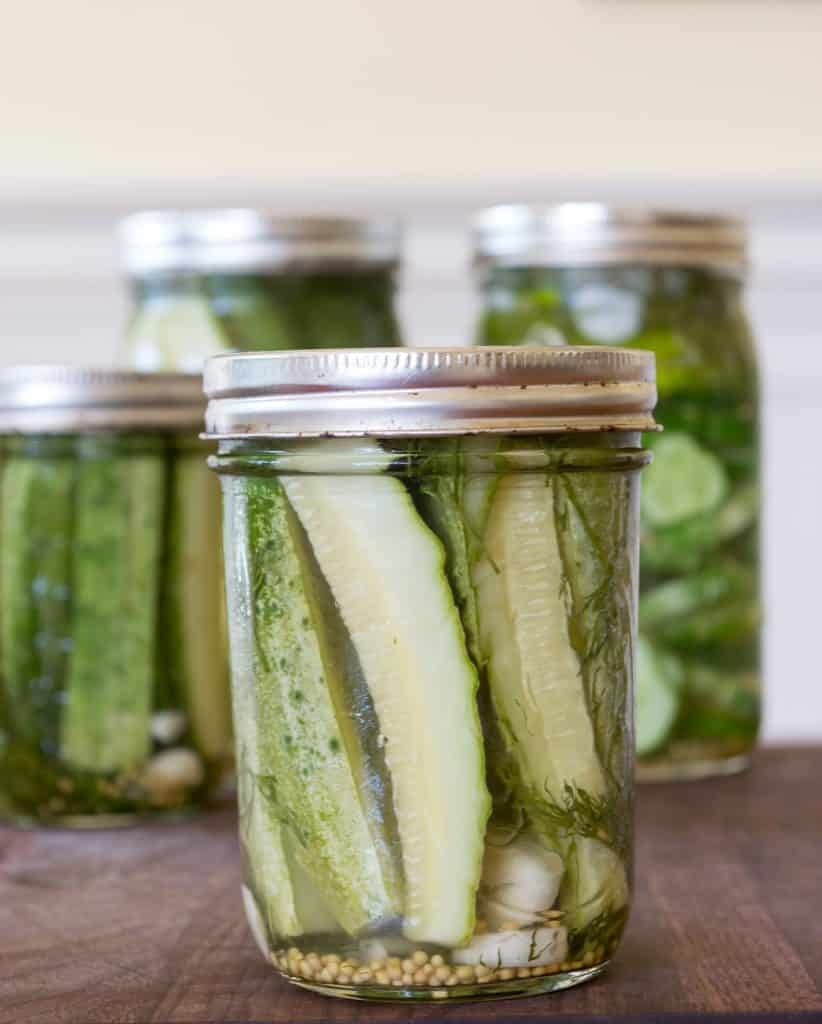
Our very popular Crisp Refrigerator Dill Pickle recipe lets you can whenever you have enough cucumbers for a jar. This jar-by-jar recipe couldn’t be easier and uses a pre-made pickle brine that you keep in the fridge.
These Pickled Jalapeño Pepper rings can be made as quick pepper pickles or water-bath can them; the recipe includes instructions for both.
Are you feeling adventurous? Try these Pickled Cranberries! There are some wonderfully fun uses for them. My brother swears by them in his holiday Old Fashioneds; they are tasty and gorgeous on your Charcuterie Board and the perfect accompaniment for turkey, ham, pork, and chicken.
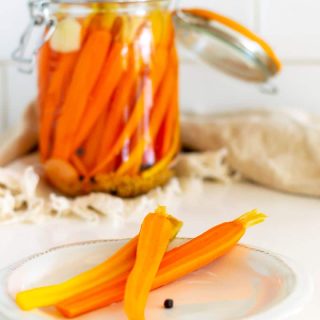
Pickled Carrots
Ingredients
- 1 pound of fresh carrots
- 2 peeled garlic cloves more for more garlicky carrots
- 1 1/2 cups white vinegar can substitute apple cider vinegar
- 1 1/2 cups water
- 1 bay leaf
- 1/4 cup of white granulated sugar
- 1 tablespoon black peppercorns
- 1 tablespoon mustard seeds
- 1 teaspoon cumin seed
- 1 teaspoon sea pickling or kosher salt
Instructions
For Quick or Refrigerator Pickled Carrots
- Peel carrots and slice them to your preference. The thinner they are, the quicker they will pickle. If you keep them long carrot sticks, ensure they will fit into your jar when lidded.
- Slice garlic cloves into 3-4 slices.
- Place carrots in a wide-mouth, heat-proof mason jar or canning jar with a lid.
- Make the pickle brine by combining vinegar, water, sugar, salt, bay leaf, peppercorns, mustard seed, sliced garlic and cumin seed in a small saucepan and bring it to a boil.
- Once the vinegar water brine comes to a boil, remove it from the stove and pour the brine over the carrots. Make sure to add all the seeds, spices, and garlic to the jars with the carrots. If you use multiple jars, divide the spices and herbs among the jars.
- Screw the lid on the jar and leave it on the counter to cool to room temperature. Once cooled, refrigerate.
- You can eat your carrots at any time but try to wait until they have fully cooled for 2 hours. They are really best after they've pickled for at least 24-48 hours in the fridge.
To Water Bath Can Your Pickled Carrots
- If you are water bath canning these pickled carrots, prepare your water bath canner, mason jars, and lids. Wash your jars and lids. Sterilize your jars in a large pot filled with water. Bring the water to almost a simmer over medium heat. Keep the jars in the simmering water until you are ready to fill them. Use a jar lifter to remove them from the water when you are ready to fill them, dumping the hot water back into the pot when you remove each jar from the water. Right before you are ready to can, put your lids in a small pot or bowl with hot, but not boiling water. Put some additional white vinegar in a small bowl alongside a clean washcloth or paper towel. Keep the water in your canning pot at a simmer while you fill your jars.
- Peel carrots and slice them to your preference. The thinner they are, the quicker they will pickle. If you keep them long carrot sticks, ensure they will fit into your jar when lidded. A standard pint, wide-mouth mason jar is 4 5/8" tall. If you use a wide-mouth mason jar, make sure the carrots are no longer than 4" to get the appropriate head space.
- Slice garlic cloves into 3-4 slices.
- Place carrots in a wide-mouth, pint mason jar.
- Make the pickle brine by combining vinegar, water, sugar, salt, bay leaf, peppercorns, mustard seed, sliced garlic, and cumin seed in a small saucepan and bring it to a boil.
- Once the vinegar water brine comes to a boil, remove it from the stove and pour the brine over the carrots. Make sure to add all the seeds, spices, and garlic to the jars with the carrots. If you use multiple jars, divide the spices and herbs among the jars. Leave 1/2" headspace.
- Remove any air bubbles.
- Wipe the rim with straight vinegar and center the lid on the jar.
- Screw on the band until it is fingertip-tight. Repeat with the remaining jars.
- When all your jars are in your canner with at least 2 inches of water over top, bring your canner to a boil.
- Once boiling, process your pint jars for 15 minutes, adjusted for altitude.
- At the end of 15 minutes, turn off the heat, remove the lid, and let the jars sit for 5 minutes.
- After 5 minutes, remove them from the water and place them where they can sit undisturbed for 24 hours.
- Refrigerate any jars whose lids don't seal.
Notes
Nutrition
So, there you have it—an easy and quick carrot pickle recipe you can also use to make your own homemade canned carrot pickle. Bookmark this page or pin the following image to return to this Quick Pickled Carrots Recipe in the future.
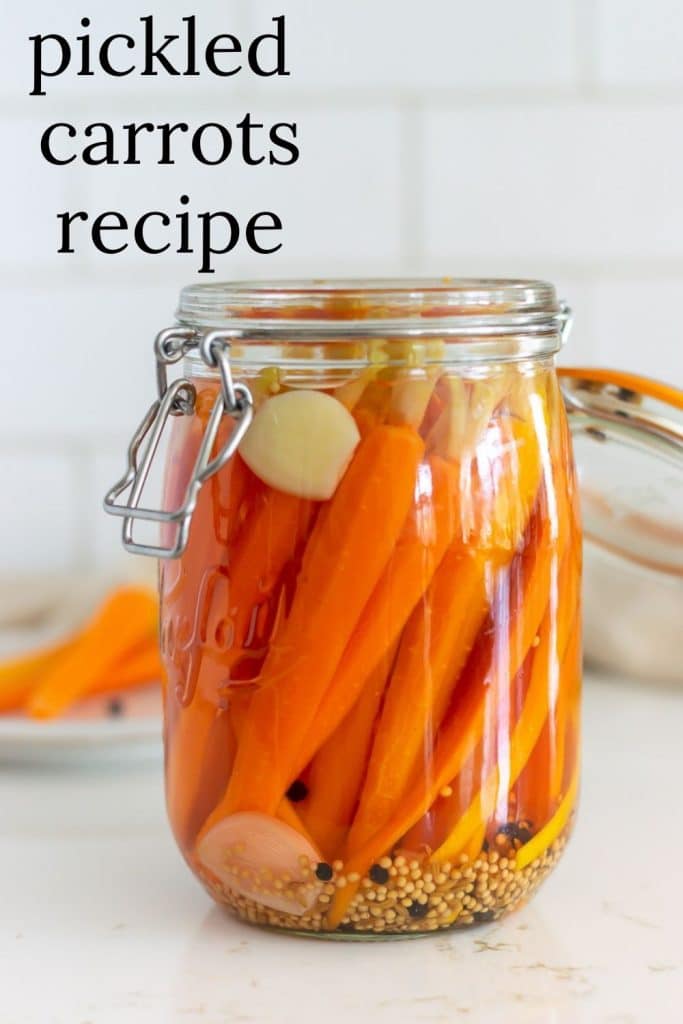
Thanks so much for spending a few minutes of your busy day with me!
To ensure you don’t miss future content, pop your email in the pale green box on the right or click here. I usually send one email weekly, so I won’t inundate your inbox. I’m sensitive to an overflowing email inbox!
We will only use your email address to send you emails, no more than 1-2 weekly. In addition, you will have access to my growing library of knit & crochet patterns and other printables. Check back often as this library will continue to grow. You can unsubscribe anytime by emailing me or clicking on the “unsubscribe” link at the bottom of all emails.
And you can access many of the products I refer to on my Nourish and Nestle Amazon Page. You can access it here.
So, if you’d like to participate in the ‘subscriber benefit’ action, simply subscribe to Nourish and Nestle here or use the form on the right sidebar. It’s slightly towards the top.
I have sent all my subscribers the link to the Subscriber Benefits Library. If you missed it or misplaced it, let me know.
Until next time…


